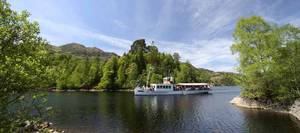Rob Roy MacGregor is one of the most romantic figures in Scottish
history, and his story has often been told in books and films such as
Sir Walter Scott’s novel and Liam Neeson’s film. Born in 1671, Rob Roy
lived all his life in the Trossachs, an area to the west of Stirling,
with mountains and forests and lochs, the most famous of which is Loch
Katrine. Rob Roy was a cattle-drover in the 17th century, walking cattle
over long distances to the markets, just as they did in later centuries
in the Wild West of America. In 1712 he was wrongly accused of a crime
and became an outlaw for years before being pardoned in 1725.
Rob
Roy’s territory was the lands around Loch Katrine. He was born in
Glengyle, he owned land at Inversnaid and Craigroyston and when he died
in 1734, he was buried in the small graveyard at Balquhidder. The
landscape has changed little in the 250 years since then, and it is easy
to imagine that the shepherd you see on the hillside is Rob Roy
returned to survey his land.
The best way to enjoy the Trossachs
is to include a cruise on board the Sir Walter Scott, a steamship built
in 1899, which sails on Loch Katrine, from the Trossachs Pier in the
east to Stronachlachar in the west. From the deck you get a superb view
of the hills, a leisurely way to explore. Afterwards you can visit Rob
Roy’s grave in Balquhidder near the shores of Loch Voil and take time to
appreciate the tranquillity of the area. If you continue along this
twisty road which runs close to the loch-side, you come to Monachyle
Mhor, a lovely little hide-away hotel.
To get to the Trossachs,
drive west from Stirling (Stirling Castle is one of the most interesting
castles in Scotland) and stop off at Doune Castle (where some of the
Monty Python series were filmed). A suggested meal-stop on the way is
the Kilmahog Woollen Mill, before driving along Loch Venachar. After
your cruise on Loch Katrine, you can return the way you came or make it a
round trip and head south through the King’s Pass and Achray Forest
(great for short walks). In the village of Aberfoyle, you will find
rather an unusual scene – sheepdogs herding ducks at the Aberfoyle
Woollen Mill, where you can also see birds of prey, as well as something
to eat and browse for gifts.
If you continue south from Aberfoyle then east, you arrive at the Lake of Menteith (this one is called a lake, not a loch). On the small island in the lake sits the ruins of Inchmahome Priory where Mary, Queen of Scots, was kept as a little girl in 1547. You reach the island on a small ferry, just as Mary would have done. You could do this on a long day out from Stirling, but my recommendation is that you opt for an overnight stay in Aberfoyle or Callendar.
Judith Sleigh
-Scottish Tourism Expert
Zusätzliche Informationen
- Webseite von Stirling Castle
- Webseite von Edinburgh Woollen Mill
- Webseite von Loch Katrine
Fotocredits: Udo Haafke / Total Film / Loch Katrine Experience

